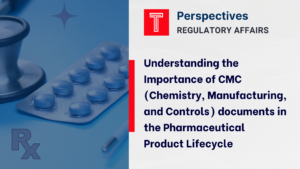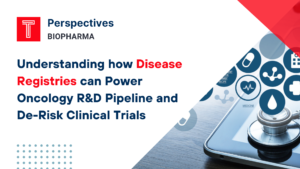Understanding how Disease Registries can Power Oncology R&D Pipeline and De-Risk Clinical Trials
Developing robust pipelines in the biotech industry presents numerous challenges, including lengthy development timelines, substantial financial investments, and the inherent risks associated with clinical trials. Sponsors can leverage disease registries to effectively navigate these complexities and optimize their scientific research and development (R&D) efforts. The data collected through disease registries can provide valuable insights from real-world patients about the natural history of diseases, treatment outcomes, and patient demographics. By integrating information from these registries into their pipeline development strategies, biotech companies can significantly enhance patient recruitment, refine trial designs, and identify gaps in current therapeutic approaches. Embracing the power of disease registries empowers biotech companies to make data-driven decisions, accelerate R&D timelines, and ultimately bring innovative treatments to patients in need.
Let’s take a closer look at how disease registries can be leveraged by biotech companies to optimize their R&D effort.
Building a Strong Pipeline
-
- Target Identification and Validation: Registries offer large datasets on specific cancer types, enabling researchers to identify genetic/molecular patterns associated with disease progression or treatment response. This helps pinpoint promising targets for drug development.
- Patient Stratification and Recruitment: Registries facilitate identifying specific patient subpopulations for clinical trials, leading to the development of drugs targeted to highly responsive groups. This improves trial efficiency and efficacy.
- Natural History Data: Studying disease progression and treatment patterns in registries helps understand the baseline course of the disease without intervention. This data guides trial design, endpoint selection, and sample size calculations, increasing trial success rates.
Proven Examples
- SWOG Cancer Registry: Used by Bayer to identify a rare genetic mutation in lung cancer patients, leading to the development of the targeted therapy Larotrectinib.
- National Cancer Institute’s SEER Program: Helped Novartis design a clinical trial for a PARP inhibitor in ovarian cancer, focusing on patients with specific BRCA mutations identified in SEER data.
- Dana-Farber Cancer Institute’s Adult Brain Tumor Registry: Provided critical data on survival rates and treatment patterns for glioma patients, enabling Blueprint Medicines to target a specific subgroup with their ALK inhibitor Lorlatinib.
De-Risking Clinical Trials:
Contact us by submitting a business inquiry online. We will get back to you very soon.
-
- Predictive Biomarkers: Registry data can be used to identify potential biomarkers for treatment response or toxicity, allowing for personalized medicine approaches. This helps tailor therapy and reduce adverse events.
- Virtual Trials and Real-World Evidence: Registries can support virtual trials by providing existing data for baseline comparisons and post-trial follow-up. This reduces costs and accelerates trials.
- Safety Monitoring and Risk Mitigation: Continuous data collection from registries allows for real-time safety monitoring of new drugs, enabling early identification and mitigation of potential side effects.
Proven Examples
- National Cancer Data Base (NCRN): Used by Pfizer to conduct virtual trials for their PD-1 inhibitor Ibrance, leveraging NCRN data for baseline comparisons and reducing patient recruitment time.
- Swedish Childhood Cancer Registry: Helped Genentech identify biomarkers predictive of response to immunotherapy in children with ALL, allowing for personalized treatment and improved trial success rates.
- NCI’s Cancer Therapy Evaluation Program (CTEP): Collaborated with multiple drug developers to monitor real-world safety and effectiveness of new cancer drugs after approval, leading to early identification and mitigation of potential adverse events.
Practical Approach on How to Leverage Disease Registries
Let’s take an example of a Biotech company that is aiming to develop bifunctional antibodies and other biologics for solid tumors. This R&D endeavor is really complex and presents unique challenges to identify potential targets, determine suitable biomarker endpoints, identify patient populations, and successfully develop a strong product pipeline. Disease registries can be invaluable assets in this process, offering real-world data and insights to strengthen pipeline development. Here’s a detailed plan on how:
1. Target Identification and Validation:
- Tumor-specific registries: Collaborate with registries focused on your target tumor type (e.g., lung, breast, colorectal) to identify genetic alterations, protein expression patterns, and treatment resistance mechanisms. Identify frequent genetic alterations, driver mutations, and tumor microenvironment characteristics associated with specific solid tumor types. Examples: TCGA (The Cancer Genome Atlas), AACR (American Association for Cancer Research) Project GENIE.
- Biomarker registries: Partner with registries collecting detailed molecular data (e.g., TCGA, TARGET) to identify potential targets for your bifunctional antibody. Analyze data for correlations between specific biomarkers and clinical outcomes to prioritize promising candidates. Explore potential predictive biomarkers for response to immunotherapy, targeted therapies, or combinations, guiding bifunctional antibody design and patient selection for trials. Examples: NCI TARGET, CPTAC (Clinical Proteomic Tumor Analysis Consortium).
- Outcome registries: Analyze long-term disease progression, treatment response, and survival data to define unmet needs and identify promising therapeutic targets. Examples: SEER (Surveillance, Epidemiology, and End Results), NCDR (National Cancer Data Registry).
- Survival registries: Utilize data from registries like SEER to understand overall survival rates and identify patient subgroups with unmet medical needs. This helps refine target selection and guide drug development towards high-impact areas.
2. Preclinical and Early Clinical Development:
- Patient recruitment: Utilize registries to identify specific subpopulations for preclinical models and early-phase clinical trials, accelerating patient enrollment and ensuring target relevance.
- Dose-finding and safety monitoring: Leverage real-world safety data from registries to inform initial dosing ranges and optimize safety protocols for early clinical trials.
- Biomarker validation: Use registry data to validate potential biomarkers identified in preclinical models, refining patient selection criteria and enhancing trial efficiency.
- Natural history data: Analyze disease progression patterns and treatment response rates in registries to inform clinical trial design. This helps define primary and secondary endpoints, sample size calculations, and patient selection criteria.
- Predictive biomarkers: Identify potential biomarkers for response or toxicity from registry data. This allows for personalized medicine approaches in trials, improving efficacy and reducing adverse events.
- Virtual trial feasibility: Assess the feasibility of virtual trials using registry data for baseline comparisons and post-trial follow-up. This can significantly reduce costs and accelerate trial timelines.
3. Patient Recruitment and Stratification:
- Utilize registry search tools: Leverage registries’ search functionalities to identify eligible patients for your clinical trials based on specific criteria (e.g., tumor type, biomarker status, treatment history).
- Patient engagement platforms: Partner with registries to reach out to potential participants through their patient engagement platforms, increasing trial awareness and recruitment rates.
- Stratification by tumor subtype or biomarker: Utilize registry data to stratify patients into subgroups for clinical trials based on relevant tumor subtypes or biomarker expression. This enhances trial precision and drug efficacy within specific patient populations.
4. Late-Stage Clinical Trials and Commercialization:
- Randomized controlled trials: Partner with registries to conduct large-scale clinical trials, leveraging their infrastructure and patient reach to accelerate study completion.
- Real-world evidence generation: Utilize registry data to track real-world effectiveness and safety of approved biologics in diverse patient populations, informing post-marketing surveillance and potential label expansions.
- Comparative effectiveness research: Compare the efficacy and safety of your biologics to standard-of-care treatments using registry data, providing valuable insights for healthcare providers and payers.
- Longitudinal data collection: Partner with registries to collect real-world data on your drug’s effectiveness and safety in the post-market setting. This provides valuable insights for further development and optimization of your biologics.
- Comparative effectiveness studies: Utilize registry data to compare the performance of your drug to existing therapies in real-world settings. This strengthens evidence for your product’s value proposition and informs future treatment guidelines.
- Safety monitoring and risk identification: Continuously monitor safety data from registries to identify potential adverse events early and implement necessary mitigation strategies.
Additional Strategies:
- Engage with registry stakeholders: Collaborate with researchers and clinicians affiliated with relevant registries to gain deeper insights into specific tumor types and treatment landscapes.
- Develop data sharing agreements: Ensure secure and ethical access to registry data while respecting patient privacy and complying with regulations.
- Invest in data analytics capabilities: Employ advanced statistical and machine learning techniques to extract meaningful insights from large registry datasets.
Remember: The specific registries and data utilized will depend on the target tumor type, mechanism of action of the biologics, and development stage of the pipeline. Adapting the plan based on evolving research and clinical findings is crucial.
By strategically leveraging disease registries, the biotech company can gain valuable insights, refine target selection, optimize clinical trial design, and ultimately bring safe and effective solid tumor biologics to patients faster.
This plan provides a comprehensive framework, but remember to tailor it to your specific context and adapt it to address emerging challenges and opportunities. By embracing data-driven approaches and fostering collaborations with registry stakeholders, your R&D efforts can lead to breakthrough treatments for patients.






